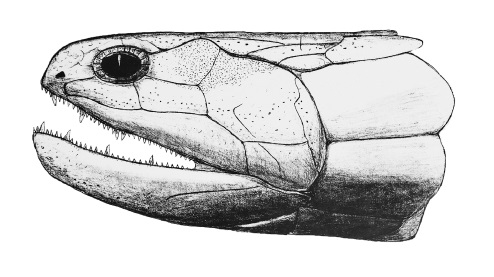Early Vertebrates
Back-boned animals (vertebrates) first evolved about 500 million years ago as simple jawless, boneless, finless kinds of fishes. Throughout the early evolution of fishes we see the development and acquisition of major anatomical structures that set up the basic body plan for all future lineages of vertebrates, such as jaws, teeth, limbs, well-developed spine, and so forth. Within the first 150 million years of vertebrate evolution we see fishes acquire all of these features, and develop the necessary structures and behaviours for the invasion of land as tetrapods.
Our research focuses on a range of fossil fishes from the Palaeozoic Era (542–252 million years ago), including the archaic yet highly interesting placoderms (ancient armoured fishes) as well as early osteichthyans (bony fishes), sharks, and tetrapods (four-limbed animals). Our research has revealed some startling discoveries about the early evolution of vertebrates, from the origins of complex sexual reproduction in the first jawed fishes like Microbrachius (Long et al., Nature, 2015), how stem-tetrapod fishes like Gogonasus and early lungfishes like Rhinodipterus began breathing air (Long et al., Nature, 2006; Clement & Long, 2010, Biology Letters), and the origin of digits within the fins of advanced bony fishes like Elpistostege (Cloutier et al., Nature, 2020).
Using well-preserved 3D fossil skulls, and cutting-edge technologies like the synchrotron and Dingo neutron beam at ANSTO, we can now virtually segment out structures in fossils even before they are prepared out of rock, revealing details of their anatomy never before seen. We collaborate with some of the leading early vertebrate research labs around the world (Prof Richard Cloutier, University of Quebec at Rimouski; Prof Per Ahlberg lab, Uppsala University, Sweden; Dr Tom Challands, university of Edinburgh, Scotland, UK; Dr Hugo Dutel, Bristol University, UK) and in Australia (Prof Kate Trinasjtic, Curtin University, Perth; Dr Gavin Young, The ANU, Canberra).
Our current projects focus on the evolution of brains in advanced lobe-finned bony fishes as they approach the invasion of land. We study fossils with exceptional preservation from sites such as Gogo in the Kimberley of Western Australia that are about 380 million years old. In recent years we have been collecting Devonian age fishes from Antarctica as well as other sites all around Australia. Some of these specimens form the basis for postgraduate research projects.
